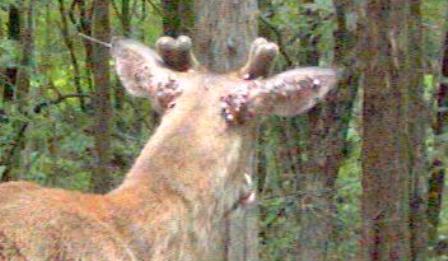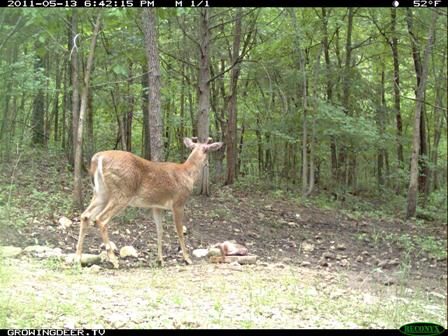A Spring Stressor for Me and the Deer Herd!
Filed under: Hunting Blog, White-tailed Deer
Brad had the following observations to share after running the trail cameras earlier today. – Grant
It’s raining cats and dogs here today at The Proving Grounds, a welcome sight since we were able to get all of our soybeans and corn planted earlier this week. Spring is the time of the year when we typically think deer have little stress due to the abundance of lush/nutritious native forage. The deer herd can definitely keep their belly full, but there are still plenty of stressors during this time of the year. The stressor that disturbs us every spring is the presence of a wad of ticks behind the ears of our bucks and does.

 The area directly behind the deer’s ear is one of the few places on their body that the removal of unwanted ticks is difficult. If they do happen to find a way to scratch them off their skin often gets opened allowing for the possibility of infection.
The area directly behind the deer’s ear is one of the few places on their body that the removal of unwanted ticks is difficult. If they do happen to find a way to scratch them off their skin often gets opened allowing for the possibility of infection.
Ticks, as you can imagine, are also directly pulling from a deer’s energy and nutrient supplies. These resources are needed for developing antlers and rapidly growing fetuses. Not to mention the constant irritation can distract them from predator avoidance and normal foraging behavior.
The best method I know of to beat down tick populations is to keep a burning rotation going from year-to-year. Ticks are not easily consumed by the fire itself because they can burrow under debris or loose soil to escape the heat. However, they are susceptible to desiccation – or drying out. With much of the herbaceous and woody material removed, the soil surface can heat up more and lower ground level humidity levels cause ticks to die. In addition, ticks picked off are not simply flicked to the side or out the truck window, they meet their demise between a finger nail and a hard place or at the strike of a match.
I hope your deer are not suffering from ticks on your Proving Grounds, but if so consider implementing prescribed fires to help reduce their presence. It may pay dividends toward more venison in the freezer and larger antlers on the wall.
Growing Deer together,
Brad



